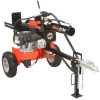Ariens 34-Ton Log Splitter Owners Manual - Page 16
FOR BEST PERFORMANCE, Warm Up Unit, Splitting Logs
 |
View all Ariens 34-Ton Log Splitter manuals
Add to My Manuals
Save this manual to your list of manuals |
Page 16 highlights
Warm Up Unit When using the unit in temperatures of 68° F (20° C) or lower, the hydraulic system should be cycled before splitting logs. This allows the cool hydraulic oil in the cylinder to be circulated before placing a load on the hydraulic system. 1. Start the engine and allow it warm up (see Excessively oxygenated or reformulated fuels (fuels blended with alcohols or ethers) can damage the fuel system or cause performance problems. If any undesirable operating problems occur, use a gasoline with a lower percentage of alcohol or ether. on page 14). 2. Cycle the cylinder through three or four full extension/retraction cycles. 3. Proceed with splitting logs. IMPORTANT: Always split logs with engine set at Fast position. Splitting Logs WARNING: AVOID INJURY. Read and understand the entire Safety section before proceeding. Determine if the size of the logs to be split can be safely and comfortably lifted up onto the beam in the horizontal position. If logs are too heavy for the operator, position the beam in the vertical position for splitting. 4. Hold the lever in the out position until log is split. 5. Allow split logs to drop to the ground. DO NOT try to catch split logs. 6. Move control lever away from the log until it locks into retract position. Lever will automatically return to neutral once cylinder is fully retracted. 7. Do not load another log or remove split pieces until the cylinder has completely stopped and the control lever is in the neutral position. Do not reach across the unit. 8. Split only one log at a time unless the cylinder has been fully extended and a second log is needed to complete the separation of the first log. 9. Move split logs as necessary to ensure that all tripping hazards have been eliminated from the operator zone. FOR BEST PERFORMANCE • Ensure that logs to be split are cut as square as possible. • Split dry, cured logs. Wet or recently cut logs will be more difficult to split. • Split logs with straight grain. Logs with knots or twisted or irregular grain patterns will be more difficult to split. • Move split logs as needed to keep operator zone free of tripping hazards. • When splitting logs that are not square place the longest portion of the log closest to the beam and the most square end against the splitter wedge. CAUTION: During operation, engine and hydraulic system are hot. Always stop engine and allow unit to cool before changing beam positions. Working only in the Operator Zone (see OPERATOR ZONE on page 6): 1. Fully retract cylinder. 2. Place log on beam: • Split only from log ends, with the grain. • Position log against grips on end plate with the squarest end toward the splitter edge. • Position hands on sides of logs when placing logs on unit and not on the end. Never place hands or any part of the body between a log and any part of the log splitter. • Do not attempt to stabilize logs with legs or feet while operating. 3. Using only your hand, push the control lever toward the log. GB - 16















